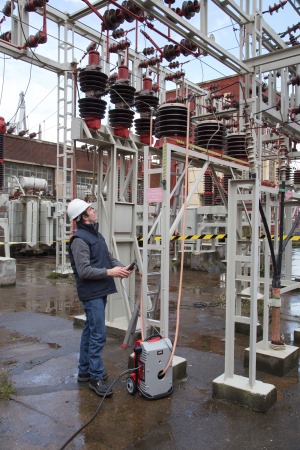Primary Test in Substations- EuroSMC Solutions
Basically, a test made through the primary side of the main protection elements can be called a primary test, which can be carried out in breakers, switchgear, busbars, current, voltage or power transformers, low voltage breakers, ground grid, etc; essentially, a test signal is injected into the primary side to determine how the equipment behaves at that particular level of signal; the primary test may require the injection of current or voltage as test signal, depending on the application.
A testing program must include a main primary test as the final step

It is usual to test individually all these components of the protection scheme in this way, in combination with the secondary tests, but this testing is not checking how the device under test interacts with the rest of the components of the protection system, so that the ultimate test is the main primary test, or through-fault test; the main primary test involves simulating a fault of enough range to trip the protection circuit, and therefore checking the functionality of the breaker, transformer, relay circuits and all associated connections; this main primary test is a procedure that can detect mistakes and avoid operation errors during the equipment commissioning that would otherwise only be detected on load.
The primary test of the whole system is the final step before energizing the substation, and includes the primary and the secondary side of the protection circuit; with the same procedure, a calculated primary current injection can be used for checking that the CT circuits are with correct level and phase angle, and verify that the relays receive the expected proper signal to operate adequately.
Accordingly, the set of primary test applications cover different testing and measurement procedures depending on the test to be applied to one device or other or to the entire system, which might require different primary test sets; it is highly desirable that the primary test set could adapt easily and without limitation to the various requirements of current, voltage and power levels, to cover the different situations of each primary test; the need of different test sets is reduced if the high current primary test equipment can also be used for other primary testing, combining in one system all these applications.
An integrated system for any primary test in commissioning and maintenance of substations
The Raptor is a smart primary test system designed as the final solution for the main primary test applications required in the commissioning and maintenance of substations, marking the difference with respect to previous existing equipment, and making any primary test faster, easier and more convenient.
EuroSMC has manufactured primary test sets for many years, having a long and knowledgeable experience in this market and the requirements of our customers; the equipment for primary test is commonly heavy and bulky, not easy to operate and variac-based, with no precise testing and even unable to perform some tests which sometimes has actually leaded to avoid this troublesome testing. All these drawbacks have been solved in the Raptor System, drastically improving the existing way to perform any primary test application in the market.
The Raptor is really portable, with the smallest size and weight of the market, which facilitates any kind of primary test application, and save staff and transportation costs.
The Hand Held Control Unit, Raptor HH, is the user-friendly interface from which the operator remotely controls and monitors all the test process; the Raptor HH detects and configures all units automatically, with an intuitive touch screen and easy control, that combined with the pre-defined test templates, makes the test configuration and execution task extremely easy and fast.
The Raptor is a modular system that provides a quick interconnection of units, synchronized through infrared, and a stable output during any primary test. Up to three transparent to the user slaves units can be added, each one increasing the power of the system in +5 KVA; the technology used in the field of high current primary test is very old, used for more than 20 years without any significant change; all units in the market are based in a variac transformer – also our LET range has been so during the last 20 years- , but the Raptor is the first unit without variac, featuring a digital waveform generator to drive a 3-KVA switching amplifier designed for up to 15 KA, providing a stable and smooth output regulation, digitally controlled.
The induction concept is not new, but it is fully new – no other unit on the market is like this – its specific use in the primary test field – reducing the connections and providing a quick performance with low size and weight; another benefit of the pass-through secondary technique is that the user can easily multiply the compliance voltage by making more than one turn with the test leads around the entire system.
The Raptor avoids the need of having several types of primary test sets; it includes a powerful measurement section, pre-defined test templates and automatic functions for testing current, voltage and power transformers, switchgear, relays, breakers, reclosers, contact resistance, ground grid, step & touch, etc. and of course, the power and capacity required to perform the main primary test of the whole system.
The system is updateable (firmware and software) through internet connection, and also expandable with units such as the Raptor HV, or high voltage slave, becoming a world-wide unique system, which integrates both high current and high voltage injection, with the suitable power, for the main maintenance and commissioning primary test applications in substations and switchgear.
Compared to rest of the primary test equipment the Raptor is smaller, lighter, more powerful, digital, easier to use, more modern, with better and more accurate technology, multifunctional, really modular, updateable, and with better results management, at a competitive price.
For more information, please check the related EuroSMC products or contact us.
